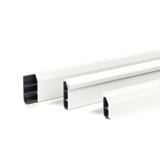I have a conservatory with just one central pendant light and would like to add table lamps on a dimmer switch. Is it OK to extend the lighting circuit by changing the one-gang switch to a two-gang dimmer and connecting two, 5 amp, round-pin sockets? Does using unfused 5 amp plugs make the lights any less safe than using them with the 13 amp plugs (fitted with 3 amp fuses) that they came with? The lighting circuit has a 6 amp trip.


